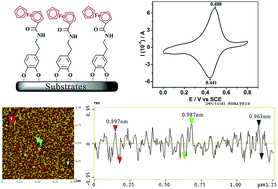Self-assembly of catecholic ferrocene and electrochemical behavior of its monolayer
Abstract
Self-assembly of catecholic ferrocene was studied on different surfaces. The self-assembly kinetics of Fc-terminated (Fc-dopamine) self-assembled monolayers (SAMs) and their stability have been studied and characterized using atomic force microscopy (AFM) and cyclic voltammetry (CV), respectively. AFM images have revealed that the self-assembly process of Fc-dopamine molecules on a mica surface follows the systematic increase of surface coverage with assembly time until a closely packed density is reached. The redox behavior of the Fc-dopamine monolayer in NaClO4 electrolyte solutions was characterized using CV, and the stability of the Fc-dopamine SAMs on an Au surface at different pH values and voltages was evaluated. CV results show that the Fc-dopamine SAMs are stable over a scan voltage range of −0.8–1.0 V under pH values lower than 11, but very rapidly destroyed above pH 11. Finally, the wetting behavior of the Fc-dopamine grafted on rough surfaces is tuned by a redox reaction of the Fc group in SAMs, which exhibits superhydrophobicity with a static water contact angle of 161° on anodized alumina surfaces, and hydrophilicity with a CA of 5° after Fc is oxidized. The work provides useful information for understanding the adhesion and deposition mechanisms of catecholic compounds on substrates.


 Please wait while we load your content...
Please wait while we load your content...